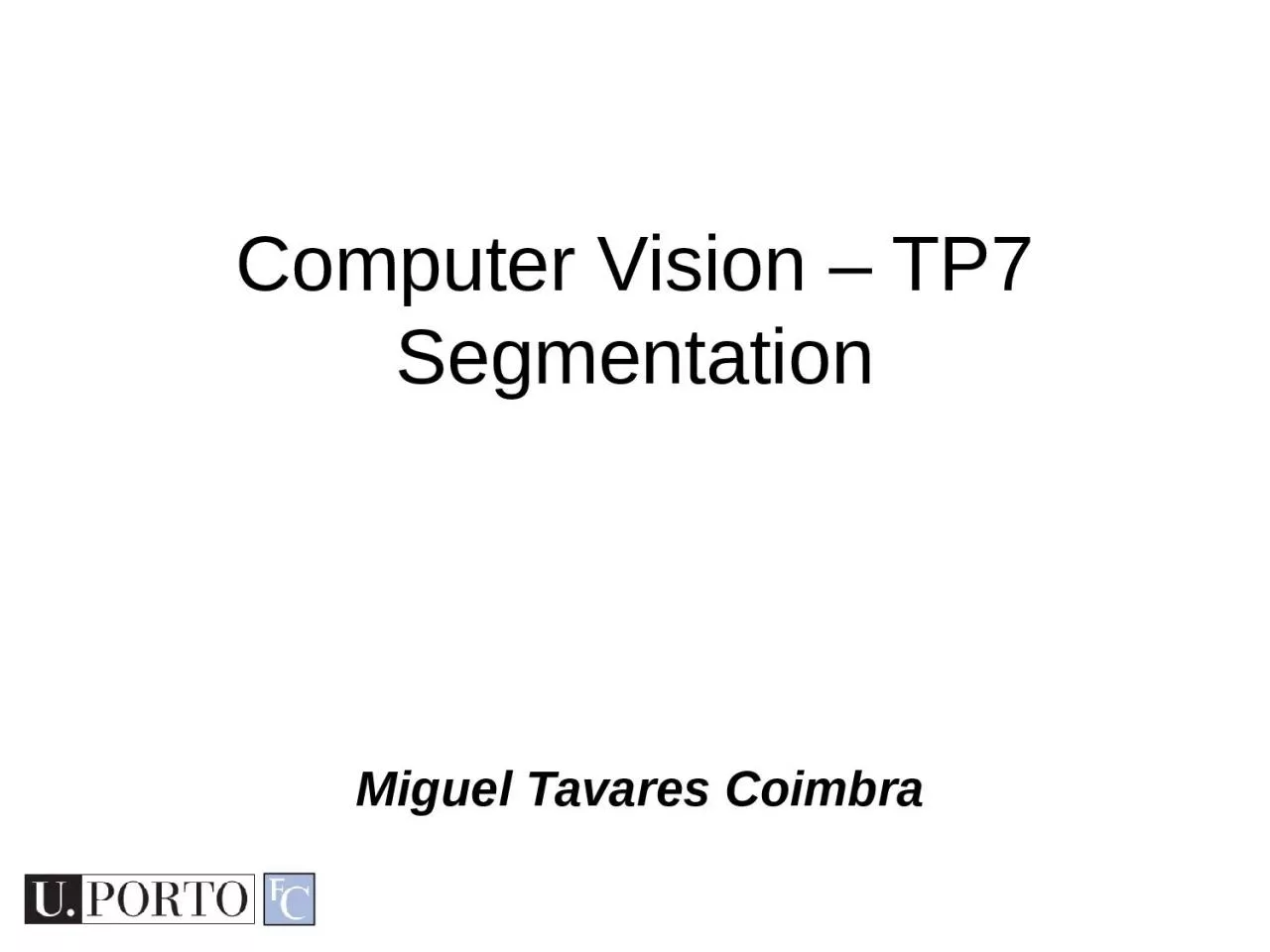

Miguel Tavares Coimbra Computer Vision TP7 Segmentation Outline Introduction to segmentation Thresholding Region based segmentation 2 Computer Vision TP7 Segmentation Topic Introduction to segmentation ID: 1012741
Download Presentation The PPT/PDF document "Computer Vision – TP7 Segmentation" is the property of its rightful owner. Permission is granted to download and print the materials on this web site for personal, non-commercial use only, and to display it on your personal computer provided you do not modify the materials and that you retain all copyright notices contained in the materials. By downloading content from our website, you accept the terms of this agreement.
1. Computer Vision – TP7SegmentationMiguel Tavares Coimbra
2. Computer Vision - TP7 - SegmentationOutlineIntroduction to segmentationThresholdingRegion based segmentation2
3. Computer Vision - TP7 - SegmentationTopic: Introduction to segmentationIntroduction to segmentationThresholdingRegion based segmentation3
4. Computer Vision - TP7 - SegmentationBoundaries of ObjectsMarked by many usershttp://www.eecs.berkeley.edu/Research/Projects/CS/vision/grouping/segbench/bench/html/images.html4
5. Computer Vision - TP7 - SegmentationBoundaries of Objects from EdgesBrightness Gradient (Edge detection) Missing edge continuity, many spurious edges5
6. Computer Vision - TP7 - SegmentationBoundaries of Objects from EdgesMulti-scale Brightness Gradient But, low strength edges may be very important6
7. Computer Vision - TP7 - SegmentationImageMachine Edge DetectionHuman Boundary Marking7
8. Computer Vision - TP7 - SegmentationBoundaries in Medical ImagingDetection of cancerous regions[Foran, Comaniciu, Meer, Goodell, 00]8
9. Computer Vision - TP7 - SegmentationBoundaries in Ultrasound ImagesHard to detect in the presence of large amount of speckle noise9
10. Computer Vision - TP7 - SegmentationSometimes hard even for humans!10
11. Computer Vision - TP7 - SegmentationWhat is ‘Segmentation’?Separation of the image in different areasObjectsAreas with similar visual or semantic characteristicsNot trivial! It is the holy grail of most computer vision problems!11
12. Computer Vision - TP7 - SegmentationSubjectivityA ‘correct’ segmentation result is only valid for a specific contextSubjectivity!Hard to implementHard to evaluatePersonSuitcaseFaceWhat is the correct segmentation?12
13. Computer Vision - TP7 - SegmentationTopic: ThresholdingIntroduction to segmentationThresholdingRegion based segmentation13
14. Computer Vision - TP7 - SegmentationCore Technique: ThresholdingDivide the image into two areas:1, if f(x,y)>K0, if f(x,y)<=KNot easy to find the ideal k magic numberCore segmentation techniqueSimpleReasonably effectiveAdequate threshold14
15. Computer Vision - TP7 - SegmentationFinding the ‘magic number’Wrong!(k = 128)Correct(k = 74)15
16. Computer Vision - TP7 - SegmentationGlobal thresholds are notalways adequate...16
17. Computer Vision - TP7 - SegmentationAdaptive ThresholdingAdapt the threshold value for each pixelUse characteristics of nearby pixelsHow?MeanMedianMean + K ...Mean of 7x7 neighborhood17
18. Computer Vision - TP7 - Segmentation7x7 window; K = 775x75 window; K = 1018
19. Otsu’s ThresholdingComputer Vision - TP7 - Segmentation19By Lucas(CA) - Own work, CC BY-SA 4.0, https://commons.wikimedia.org/w/index.php?curid=67144384Is there an optimal threshold for a bimodal distribution?YesGist: Minimize Within-Class VarianceAlternatively: Maximize Between-Class Variance
20. Within Class VarianceClass VarianceThe lower the variance, the less dispersed the data is for each classWithin Class VarianceWeighted sum of each class variance: Background (b); Foreground (f)Computer Vision - TP7 - Segmentation20 Xi is the pixel value, μ is the mean, and N is the number of pixels in one image Wj is the percentage of image pixels belonging to class j
21. Computer Vision - TP7 - Segmentation21Link: http://www.labbookpages.co.uk/software/imgProc/otsuThreshold.html
22. Computer Vision - TP7 - Segmentation22Link: http://www.labbookpages.co.uk/software/imgProc/otsuThreshold.html
23. Computer Vision - TP7 - SegmentationTopic: Region based segmentationIntroduction to segmentationThresholdingRegion based segmentation23
24. Computer Vision - TP7 - SegmentationWhy Region Based Segmentation?SegmentationEdge detection and Thresholding not always effectiveHomogenous regionsRegion-based segmentationEffective in noisy images24
25. Computer Vision - TP7 - SegmentationDefinitionsBased on setsEach image R is a set of regions RiEvery pixel belongs to one regionOne pixel can only belong to a single regionR1R3R2R4R6R5R725
26. 26Computer Vision - TP7 - Segmentation
27. 27Computer Vision - TP7 - SegmentationR1R3R2R4R6R5R7
28. Computer Vision - TP7 - SegmentationBasic FormulationLet R represent the entire image region. Segmentation partitions R into n subregions, R1, R2, ..., Rn, such that:a)b)c)d)e)Every pixel must be in a regionPoints in a region must be connectedRegions must be disjointAll pixels in a region satisfy specific propertiesDifferent regions have different properties28
29. Computer Vision - TP7 - SegmentationHow do we form regions?Region GrowingRegion MergingRegion SplittingSplit and MergeWatershed...What a computer sees29
30. Computer Vision - TP7 - SegmentationRegion growingGroups pixels into larger regions.Starts with a seed region.Grows region by merging neighboring pixels.Iterative processHow to start?How to iterate?When to stop?InitialRegionsIterationsStopConditionFinish30
31. Computer Vision - TP7 - Segmentation31
32. Computer Vision - TP7 - SegmentationRegion mergingAlgorithmDivide image into an initial set of regionsOne region per pixelDefine a similarity criteria for merging regionsMerge similar regionsRepeat previous step until no more merge operations are possible32
33. Computer Vision - TP7 - SegmentationSimilarity CriteriaHomogeneity of regions is used as the main segmentation criterion in region growinggray level color, texture shape model etc. Choice of criteria affects segmentation results dramatically!33
34. Computer Vision - TP7 - SegmentationGray-Level CriteriaComparing to Original Seed PixelVery sensitive to choice of seed pointComparing to Neighbor in RegionAllows gradual changes in the regionCan cause significant driftComparing to Region StatisticsActs as a drift dampenerOther possibilities!34
35. Computer Vision - TP7 - SegmentationRegion splittingAlgorithmOne initial set that includes the whole imageSimilarity criteriaIteratively split regions into sub-regionsStop when no more splittings are possibleR1R1R2R3R4R1R2R3R4R6R5R7R1R3R2R4R6R5R735
36. Computer Vision - TP7 - Segmentation[Machine Vision; David Vernon]36
37. Computer Vision - TP7 - SegmentationSplit and MergeCombination of both algorithmsCan handle a larger variety of shapesSimply apply previous algorithms consecutively37
38. Computer Vision - TP7 - SegmentationThe Watershed TransformGeographical inspirationShed water over rugged terrainEach lake corresponds to a regionCharacteristicsComputationally complexGreat flexibility in segmentationRisk of over-segmentation38
39. Computer Vision - TP7 - SegmentationThe Drainage AnalogyTwo points are in the same region if they drain to the same pointCourtesy of Dr. Peter Yim at National Institutes of Health, Bethesda, MD 39
40. Computer Vision - TP7 - SegmentationThe Immersion Analogy40
41. Computer Vision - TP7 - Segmentation[Milan Sonka, Vaclav Hlavac, and Roger Boyle]41
42. Computer Vision - TP7 - SegmentationOver-SegmentationOver-segmentationRaw watershed segmentation produces a severely oversegmented image with hundreds or thousands of catchment basinsPost-ProcessingRegion mergingEdge informationEtc.42
43. Computer Vision - TP7 - SegmentationResourcesSzeliski, “Computer Vision: Algorithms and Applications”, Springer, 2011Chapter 5 – “Segmentation”43